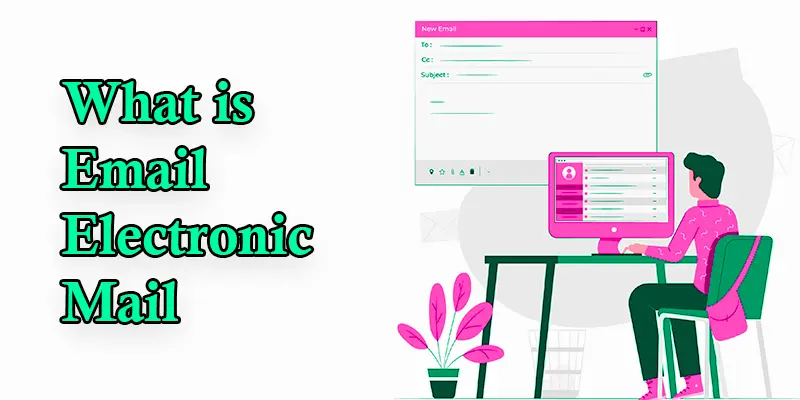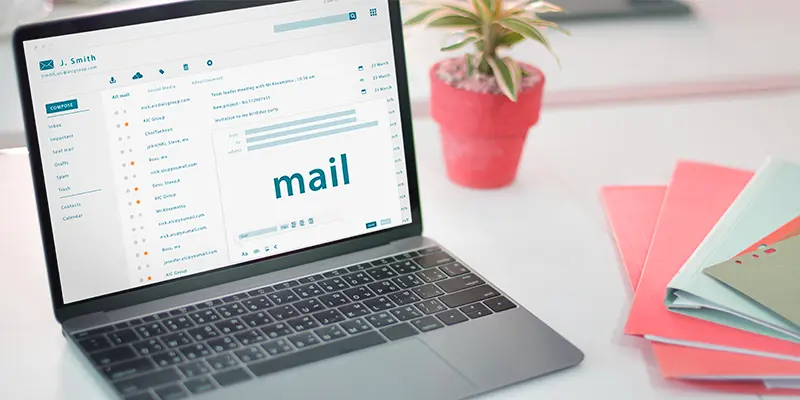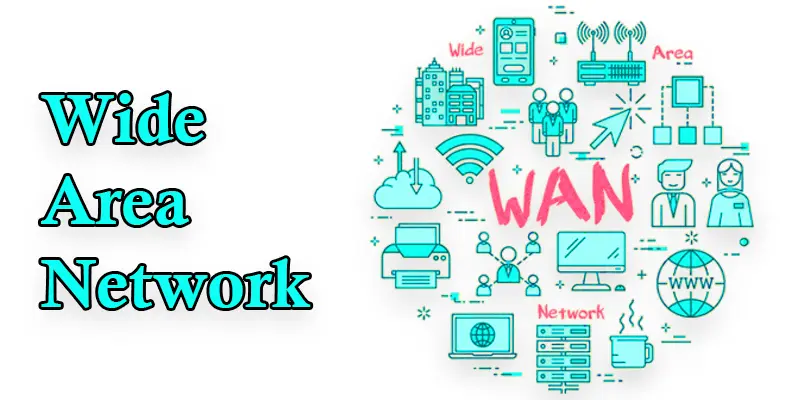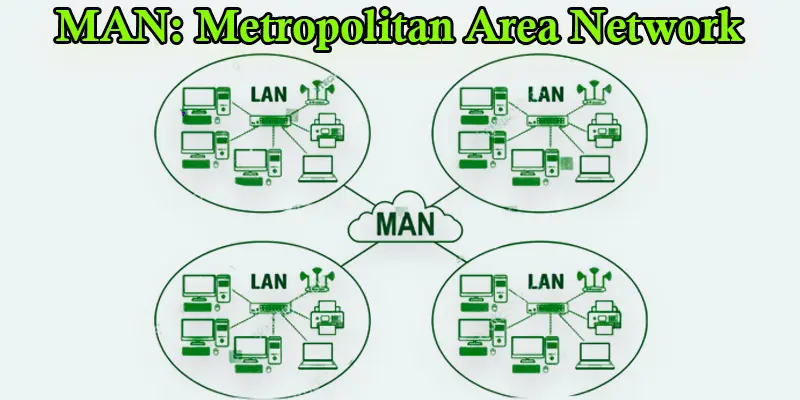What is an email – Uses, Types, History, Advantages and Disadvantages
Published: 24 Aug 2024
What is Email (Electronic Mail)?
Email, short for electronic mail, is a rapid and simple method of sending files and messages over the Internet. Just like sending a letter through the postal service, email lets you communicate with anyone around the world, but instead of using paper and a mailbox, you use your computer or smartphone. You compose your message, insert the email address of the receiver, and press send. The message travels through the internet and arrives almost instantly in the recipient’s inbox. Email is a fast, convenient, and widely used tool for both personal and professional communication.
How does email work?
- Compose Your Message: You write your email using an email app or service on your computer or smartphone.
- Add Recipient’s Address: You type in the recipient’s email address to send your message.
- Send the Email: When you click “send,” your email is sent to an email server, which is a computer system that handles sending and receiving emails.
- Email Server Processing: The email server checks where your email should go and forwards it to the recipient’s email server.
- Email Delivery: The email is saved in the recipient’s inbox after being received by their email server.
- Check Inbox: The recipient can then open their email app or service to read your message.
- Reply or Forward: The recipient can reply to your email or forward it to others if needed.
What is an email client?
- Definition: An email client is a program or app used to manage and access your email.
- Access Emails: It allows you to send, receive, and organize your email messages.
- Examples: The Gmail app, Apple Mail, and Microsoft Outlook are examples of common email applications.
- User Interface: Provides a user-friendly interface where you can view your inbox, compose new messages, and manage your email folders.
- Synchronization: It connects to your email server to sync your messages, so you can access your emails from different devices.
- Features: Often includes features like filtering, searching, and organizing emails, as well as integrating with calendars and contacts.
Main Components of an Email Message
1. Subject Line: This is the title of your email. It gives the recipient a quick idea of what your email is about.
2. Sender’s Address: This shows who is sending the email. It’s usually displayed as an email address, so the recipient knows where the message is coming from.
3. Recipient’s Address: The recipient’s email address is entered here when sending a message. It provides the email system with the message’s delivery location.
4. Body: This is the main part of your email where you write your message. It’s where you include all the information you want to communicate.
5. Signature: This is an optional section at the end of the email, usually containing your name and contact information. It helps the recipient know who you are and how to contact you back.

Uses of Email
- Sending Messages: Email lets you quickly send text messages to friends, family, or colleagues, no matter where they are in the world.
- Sharing Files: You can attach documents, photos, and other files to your email, making it easy to share important information.
- Scheduling Appointments: Many people use email to send invitations for meetings or events and to keep track of their schedules.
- Receiving Updates: Businesses and services use email to send newsletters, updates, and promotional offers, keeping you informed about new products or news.
- Professional Communication: Email is commonly used for work-related communication, such as discussing projects, collaborating with team members, and managing tasks.
Types of Email
1. Personal Email: Messages sent between friends and family for casual communication, updates, and socializing.
2. Work Email: Emails used for professional purposes, such as discussing projects, sending reports, or coordinating with colleagues.
3. Marketing Email: Emails sent by businesses to promote products, share deals, or provide updates to customers.
4. Transactional Email: Emails triggered by specific actions, like order confirmations, receipts, or password reset instructions.
5. Newsletter Email: Regular updates from companies, organizations, or individuals that include news, tips, and other interesting content.
6. Support Email: Emails used for customer service, where you can ask questions, report issues, or get help with a product or service.
7. Invitation Email: Emails sent to invite people to events, meetings, or social gatherings, including details about the time, place, and purpose.
History of Email
- Early Beginnings (1960s): The concept of sending messages between computers started in the 1960s. Early systems allowed users to send simple text messages to each other on the same computer network.
- First Email (1971): The first real email was sent by Ray Tomlinson, a computer engineer, in 1971. He used the “@” symbol to separate the sender’s name from the computer they were using, which became a key part of email addresses.
- Email Becomes Popular (1980s): During the 1980s, email systems became more common in universities and businesses. People began using email more frequently to communicate and share information.
- Modern Email (1990s): The 1990s saw the rise of internet-based email services like Hotmail and Yahoo Mail. These services made it easy for anyone with an internet connection to send and receive email from anywhere in the world.
- Email Today (2000s and Beyond): Email is becoming a vital tool for both personal and business communication. It’s used for everything from sending messages and sharing files to marketing and customer service. Email continues to evolve with new features and technologies, making it faster and more efficient.
Why use Email?
Email allows for fast and efficient communication, letting you send messages and share files instantly with anyone around the world. It provides easy access from various devices and keeps a written record of conversations, which is useful for tracking important details. Additionally, it’s a standard tool for professional interactions, helping manage business tasks and maintain organization.
What is an email address?
- Unique Identifier: A distinct string of characters used to identify and communicate with a particular individual is called an email address.
- Format: It usually consists of two main parts separated by an “@” symbol. For example, in “[email protected],” “example” is the user name, and “example.com” is the domain.
- User Name: The part before the “@” symbol identifies the individual or organization.
- Domain: The part after the “@” symbol specifies the email service provider or domain where the email is hosted.
- Purpose: It allows you to receive and send emails, helping others know where to contact you.

Popular Email Site
- Gmail: Provided by Google, Gmail offers a clean interface, strong spam filtering, and integration with Google’s suite of apps, including Google Drive and Google Calendar. It’s widely used for both personal and professional communication.
- Outlook: Microsoft’s Outlook provides a comprehensive email experience with features like calendar integration, task management, and connectivity with other Microsoft Office apps. It’s commonly used in business environments.
- Yahoo Mail: Yahoo Mail offers generous storage, a customizable interface, and built-in tools for managing emails and attachments. It also features advanced search and organizational options.
- Apple Mail: Apple Mail, renowned for its easy-to-use interface and flawless integration with Apple’s ecosystem, is the default email client for macOS and iOS devices. It supports various email accounts and offers strong privacy features.
- AOL Mail: AOL Mail provides a straightforward email experience with basic features and a familiar interface. It’s known for its simplicity and ease of use, catering to a loyal user base.
- Zoho Mail: Zoho Mail focuses on business communication, offering a clean, ad-free interface and integration with Zoho’s suite of productivity tools. It’s popular among small to medium-sized businesses.
- ProtonMail: ProtonMail is renowned for its emphasis on security and privacy, providing end-to-end encryption for emails. It’s ideal for users who prioritize confidentiality and secure communication.
- Mail.com: Mail.com allows users to choose from a variety of domain options for their email addresses and provides features like customizable email templates and ample storage. It caters to those looking for a personalized email experience.
Difference Between Email and Webmail
- Access Method:
- Email: Refers to the broader concept of sending and receiving electronic messages. It can be accessed through various email clients, such as Microsoft Outlook or Apple Mail, which download messages to your device.
- Webmail: A specific type of email service that you access through a web browser (e.g., Gmail, Yahoo Mail). It doesn’t require installing software, and your emails are stored online.
- Storage:
- Email: With traditional email clients, messages are often downloaded and stored locally on your device. This means you can access them without an internet connection.
- Webmail: Emails are stored on servers provided by the webmail service. You need an internet connection to access them, as they are not stored on your local device.
- Features:
- Email: Email clients can offer advanced features like offline access, integration with other desktop applications, and customizable settings.
- Webmail: Webmail services are typically more straightforward and are designed to be used through a browser. They offer features like spam filtering, search functions, and easy access from any device with internet access.
- Synchronization:
- Email: Traditional email clients may require manual synchronization between your email server and your device, which can lead to occasional delays.
- Webmail: Webmail services automatically sync your email in real-time across all devices, ensuring you see the same messages and folders no matter where you log in.
- Software Requirements:
- Email: Requires dedicated software to be installed on your computer or mobile device to manage your messages.
- Webmail: You can access your email account using a web browser; no software needs to be installed.
Advantages of Email
1. Instant Delivery: Emails are delivered almost immediately, allowing for quick communication regardless of distance or time zone.
2. Easy Sharing: You can attach files, documents, and photos to your emails, making it simple to share important information with others.
3. Cost-Effective: Sending emails is usually free or less expensive than making phone calls or using regular mail, especially when communicating internationally.
4. Record Keeping: Emails give you a written record of all of your discussions and transactions, which helps keep track of significant information and create a history.
5. Accessible Anywhere: As long as you have an internet connection, you may check and send emails from a variety of devices, including PCs, smartphones, and tablets.

Disadvantages of Email
1. Spam and Junk Mail: Your inbox can get cluttered with unwanted emails, including advertisements and scams, making it harder to find important messages.
2. Miscommunication: Confusion might result when there is no face-to-face engagement since it is simple for communications to be misinterpreted or for the tone to be unclear.
3. Security Risks: Emails can be hacked or intercepted, potentially exposing sensitive information if not properly protected.
4. Overload: Receiving a large number of emails can be overwhelming and lead to email fatigue, making it challenging to manage and respond to all messages promptly.
5. Dependence on Technology: Accessing email requires an internet connection and a device, so if you’re offline or have technical issues, you may miss important messages.
What is email security?
The policies and procedures used to safeguard your email correspondence against theft, illegal access, and other security risks are referred to as email security. Here are some key aspects of email security:
- Encryption: Encoding emails is the process of making them unreadable by anyone other than the intended receiver. Encryption helps protect your emails from being intercepted and read by unauthorized parties.
- Spam Filters: These tools help block unwanted and potentially harmful emails, such as phishing attempts and malware, from reaching your inbox.
- Strong Passwords: Creating strong, one-of-a-kind passwords for your email account can aid in preventing unwanted access.
- Regular Updates: Updating your security software and email client can help shield you from the newest attacks and vulnerabilities.
What are email attacks?
Email attacks are malevolent attempts to propagate malware, obtain unauthorized access, or steal information by taking advantage of weaknesses in email systems.
Examples of Email Attacks
- Phishing Email: An email claiming to be from your bank asking for account verification.
- Spear Phishing: A targeted email that appears to be from your boss asking for sensitive company information.
- Spoofing Email: An email that looks like it’s from a trusted contact but is actually from an attacker.
- Malware Attachment: An email with a disguised attachment that, when opened, installs malware on your device.
- Business Email Compromise (BEC): An email impersonating a CEO requesting a fraudulent wire transfer.
Conclusion on the email what is email
Email, or electronic mail, is a powerful and essential tool for modern communication. It enables people to send and receive messages, share files, and manage professional and personal interactions quickly and efficiently. Despite its many advantages, such as instant delivery and easy access, email also comes with challenges, including security risks and the potential for misuse. Understanding the basics of how email works, its benefits, and its vulnerabilities helps users make the most of this versatile communication method while staying informed and cautious about potential threats.
FAQS (Frequently Asked Questions) email What is an email
What is Email Marketing?
Email marketing is a strategy used by businesses to promote products or services, build relationships with customers, and drive sales by sending targeted emails to a group of recipients.
An email server: what is it?
An email server is a computer system that controls email sending, receiving, and storing. Emails are sent via a backend system from the sender to the recipient.
An email security gateway: what is it?
A device or service that filters incoming and outgoing email traffic to guard against dangers like malware, phishing, and spam is known as an email security gateway. It serves as a line of defense between the outside world and your email server.
What is an Email ID?
An email ID is another term for an email address. It uniquely identifies a user’s email account and is used to send and receive emails.
What is an Email with an Example?
A digital message transmitted via the internet is called an email. An email with the subject “Meeting Reminder” and information about the next meeting in the body might be sent, for instance, to a coworker.
What is an Email Signature?
A text block that is automatically appended to the end of emails is known as an email signature. It typically contains your name, job title, contact details, and occasionally a tagline or logo for the business.
What is an Email Domain?
The portion of an email address that appears after the “@” symbol is known as the email domain. It represents the service provider or organization that hosts the email account (e.g., in “[email protected],” “example.com” is the domain).

- Be Respectful
- Stay Relevant
- Stay Positive
- True Feedback
- Encourage Discussion
- Avoid Spamming
- No Fake News
- Don't Copy-Paste
- No Personal Attacks

- Be Respectful
- Stay Relevant
- Stay Positive
- True Feedback
- Encourage Discussion
- Avoid Spamming
- No Fake News
- Don't Copy-Paste
- No Personal Attacks





